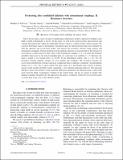| dc.contributor.author | DeCross, Matthew P. | |
| dc.contributor.author | Kaiser, David I. | |
| dc.contributor.author | Prabhu, Anirudh | |
| dc.contributor.author | Prescod-Weinstein, Chanda | |
| dc.contributor.author | Sfakianakis, Evangelos I. | |
| dc.date.accessioned | 2018-05-21T15:16:42Z | |
| dc.date.available | 2018-05-21T15:16:42Z | |
| dc.date.issued | 2018-01 | |
| dc.date.submitted | 2016-11 | |
| dc.identifier.issn | 2470-0010 | |
| dc.identifier.issn | 2470-0029 | |
| dc.identifier.uri | http://hdl.handle.net/1721.1/115537 | |
| dc.description.abstract | This is the second in a series of papers on preheating in inflationary models comprised of multiple scalar fields coupled nonminimally to gravity. In this paper, we work in the rigid-spacetime approximation and consider field trajectories within the single-field attractor, which is a generic feature of these models. We construct the Floquet charts to find regions of parameter space in which particle production is efficient for both the adiabatic and isocurvature modes, and analyze the resonance structure using analytic and semianalytic techniques. Particle production in the adiabatic direction is characterized by the existence of an asymptotic scaling solution at large values of the nonminimal couplings, ξ[subscript I]≫1, in which the dominant instability band arises in the long-wavelength limit, for comoving wave numbers k→0. However, the large-ξ[subscript I] regime is not reached until ξ[subscript I]≥O(100). In the intermediate regime, with ξ[subscript I]∼O(1–10), the resonance structure depends strongly on wave number and couplings. The resonance structure for isocurvature perturbations is distinct and more complicated than its adiabatic counterpart. An intermediate regime, for ξ[subscript I]∼O(1–10), is again evident. For large values of ξ[subscript I], the Floquet chart consists of densely spaced, nearly parallel instability bands, suggesting a very efficient preheating behavior. The increased efficiency arises from features of the nontrivial field-space manifold in the Einstein frame, which itself arises from the fields’ nonminimal couplings in the Jordan frame, and has no analog in models with minimal couplings. Quantitatively, the approach to the large-ξ[subscript I] asymptotic solution for isocurvature modes is slower than in the case of the adiabatic modes. | en_US |
| dc.description.sponsorship | United States. Department of Energy (Contract DE-SC0012567) | en_US |
| dc.publisher | American Physical Society | en_US |
| dc.relation.isversionof | http://dx.doi.org/10.1103/PhysRevD.97.023527 | en_US |
| dc.rights | Article is made available in accordance with the publisher's policy and may be subject to US copyright law. Please refer to the publisher's site for terms of use. | en_US |
| dc.source | American Physical Society | en_US |
| dc.title | Preheating after multifield inflation with nonminimal couplings. II. Resonance structure | en_US |
| dc.type | Article | en_US |
| dc.identifier.citation | DeCross, Matthew P. et al. "Preheating after multifield inflation with nonminimal couplings. II. Resonance structure." Physical Review D 97, 2 (January 2018): 023527 © 2018 American Physical Society | en_US |
| dc.contributor.department | Massachusetts Institute of Technology. Department of Physics | en_US |
| dc.contributor.mitauthor | DeCross, Matthew P. | |
| dc.contributor.mitauthor | Kaiser, David I. | |
| dc.contributor.mitauthor | Prabhu, Anirudh | |
| dc.relation.journal | Physical Review D | en_US |
| dc.eprint.version | Final published version | en_US |
| dc.type.uri | http://purl.org/eprint/type/JournalArticle | en_US |
| eprint.status | http://purl.org/eprint/status/PeerReviewed | en_US |
| dc.date.updated | 2018-02-07T20:54:52Z | |
| dc.language.rfc3066 | en | |
| dc.rights.holder | American Physical Society | |
| dspace.orderedauthors | DeCross, Matthew P.; Kaiser, David I.; Prabhu, Anirudh; Prescod-Weinstein, Chanda; Sfakianakis, Evangelos I. | en_US |
| dspace.embargo.terms | N | en_US |
| dc.identifier.orcid | https://orcid.org/0000-0002-5054-6744 | |
| dspace.mitauthor.error | true | |
| mit.license | PUBLISHER_POLICY | en_US |
